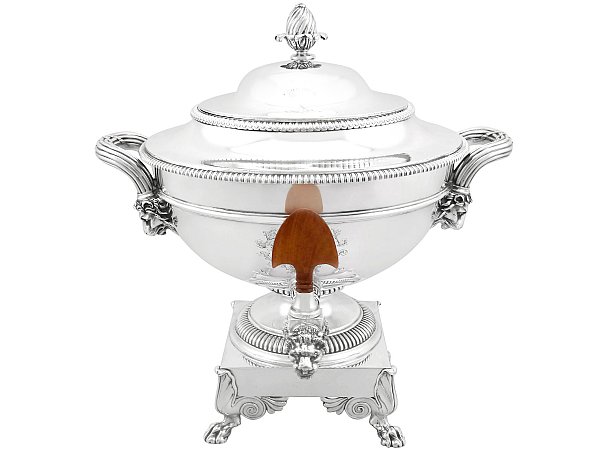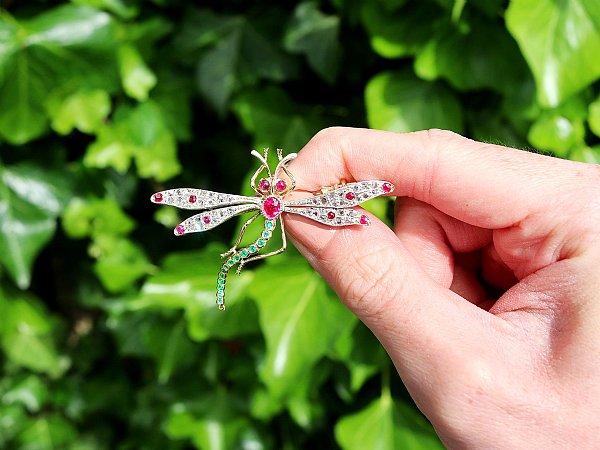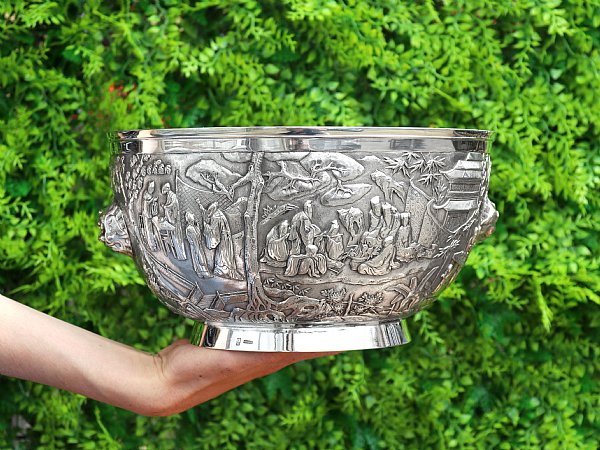Search Results for: '{{searchText}}'
Sorry...
We don't seem to have what you're looking for.
However we do have thousands of magnificent pieces of silver and jewellery available for you to view online. Browse our store using one of these categories.
Please wait for loading data... 
AC Silver is proud to present an fine selection of vintage and antique sterling silver spirit tea kettles for sale.
We are proud to be able to offer our customers a range of antique sterling silver spirit tea kettles from the Georgian, Victorian and Edwardian eras.
Andrew Campbell selects only the finest antique and vintage silver teaware to add to the AC Silver inventory.
All of the sterling silver spirit tea kettles at AC Silver come with free and insured worldwide shipping and a 14 day return policy.

A spirit kettle is a silver teapot or kettle that sits upon a stand and has a burner beneath it. It is aptly named ‘spirit’ kettle because the burner often used spirits to fuel a flame. Sometimes spirit kettles come with a tray to prevent drips and heat reaching the table. Most spirit kettle stands had three or four legs, with the burner situated at mid height between the legs, allowing the presence of the flame to be seen. Some spirit kettles are attached to the base and burner with a chain, secured by a removable locking pin (pictured). Although the form of the spirit kettle does vary, there are some common shapes to the teapot on top of the stand; they can be pear shaped, bulbous, bullet-shaped, oval, spherical, or melon-shaped.
A spirit kettle is a silver teapot or kettle that sits upon a stand and has a burner beneath it. It is aptly named ‘spirit’ kettle because the burner often used spirits to fuel a flame. Sometimes spirit kettles come with a tray to prevent drips and heat reaching the table. Most spirit kettle stands had three or four legs, with the burner situated at mid height between the legs, allowing the presence of the flame to be seen. Some spirit kettles are attached to the base and burner with a chain, secured by a removable locking pin. Although the form of the spirit kettle does vary, there are some common shapes to the teapot on top of the stand; they can be pear shaped, bulbous, bullet-shaped, oval, spherical, or melon-shaped.
It would seem that the spirit kettle fell into disfavour around 1770, due to the introduction of the tea urn (sometimes referred to as a samovar - pictured). Tea urns were used for the same purposes as the spirit kettle, to warm water in order to replenish water in the teapot. The tea urn is fitted with a tap at the bottom of the body and stands on a base.
It was in the Victorian era when spirit kettles were reintroduced and this resurgence was possibly due to the discovery of odourless spirits for the burner.
A spirit kettle is a teapot or kettle that sits upon a stand and has a burner beneath it. It is aptly named ‘spirit’ kettle because the burner often used spirits to fuel a flame. Sometimes spirit kettles come with a tray to prevent drips and heat reaching the table. Most spirit kettle stands had three or four legs, with the burner situated at mid height between the legs, allowing the presence of the flame to be seen. Some spirit kettles are attached to the base and burner with a chain, secured by a removable locking pin (pictured). Although the form of the spirit kettle does vary, there are some common shapes to the teapot on top of the stand; they can be pear shaped, bulbous, bullet-shaped, oval, spherical, or melon-shaped.
The earliest reference to a spirit kettle is in the year 1687, yet rose in popularity during the reign of Queen Anne. During this time these extravagant kettles became an indispensable accessory to any elaborate formal tea party. The reason behind this is not just the aesthetic appearance of the antique silver; which was usually highly ornate and decorative, nor was it that some spirit kettles matched the overall design of the tea set; which was often the case. It was instead that the spirit kettle served a very utilitarian purpose, and they were originally used to replenish the teapots when brewing tea. Teapots at this time were usually rather small, due to the luxurious and expensive nature of tealeaves, thus the teapot often needed to be refilled.
It would seem that the spirit kettle fell into disfavour around 1770, due to the introduction of the tea urn (often referred to as a samovar). Tea urns were used for the same purposes as the spirit kettle, to warm water in order to replenish water in the teapot. The tea urn is fitted with a tap at the bottom of the body and stands on a base.
It was in the Victorian era when spirit kettles were reintroduced and this resurgence was possibly due to the discovery of odourless spirits for the burner.
The word samovar is derived from two Russian words, 'samo' – self, and 'varit' – to boil i.e. 'self-boiling'.
A samovar is a metal container, used to heat or boil water. The heated water is typically used for tea and the teapot is filled from an attached spigot to the anterior surface. A traditional samovar incorporates a solid pipe through the middle used to store ignited fuel, allowing the surrounded water to be heated.
Samovars can come in a variety of shapes including: url, barrel, cylinder and sphere. There is no set size for a samovar, they can range from holding approximately a single litre to multiple pales; offering over 50 cups of water for tea.
Whilst the history of the samovar prior to the 18th century is unknown it can be determined some influence was obtained from the Greek water-heater, the autepsa; this comprised of a vase with a central tube used to hold coal.
The first historically recorded samovar-makers were Russian Lisitsyn brothers, Ivan Fyodorovich and Nazar Fyodorovich, and in 1778 they registered the first samovar-marking factory in Tula, Russia. Whilst they may have not been the inventors of the piece, they became influential throughout the later years due to their innovative and aesthetically pleasing designs. By 1826, there were eight samovar factories. This increased to seventy such factories by the late 1800s.
By the 19th century the samovar was a stable within Russian teaware culture from peasants to well-suited people, thus the industry enabled the craftmanship to expand and pieces to be exported to areas such as Central Asia.
The samovar was not just utilised as a hot water provider, slow burning items were utilised as fuel, such as charcoal and dry pinecones, allowing for when the samovar was not in use the embers inside would be easily rekindled, and the whole piece acted as a heat source.
Through the development of the design, teaware culture and worldwide influence, kerosene or spirit was later used as fuel to heat the central element, and latterly in the mid-1900s, electricity.




